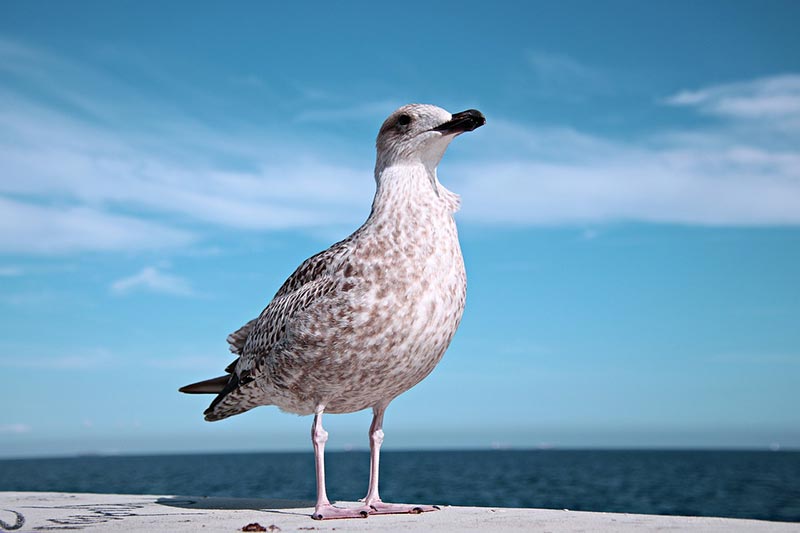Can You Hunt Seagulls? Legalities, Laws, & FAQ
Last Updated on

Guidance on legally and humanely treating pest birds, such as pigeons and seagulls, is a complex discussion with many conflicting perspectives. Hunters are responsible for ensuring that none of their practices involves a felony.
If you’re wondering whether you can hunt seagulls, the short answer is no. Seagulls are a protected species as there are multiple laws and regulations prohibiting the hunting of seagulls. This article covers all the legal guidelines regarding illegally eliminating pigeons and seagulls from your area.

Is It Legal to Hunt Seagulls?
All species of gull are protected by the Wildlife and Countryside Act 1981¹. This law makes it illegal to deliberately or recklessly harm or kill any seagull or ruin a lively nest or its contents. It’s also unlawful to stop birds from gaining access to their nest or disturbing any nesting bird.
In addition, the Mediterranean gull is guarded below Schedule 1 of the act, which makes it illegal to disturb the birds at their nest, go near their nest aimlessly, or disturb their young.
However, the law acknowledges that control measures can be necessary during certain situations, but any irrelevant reasons or minor harm doesn’t make it legal to kill gulls. If necessary, the U.K. administration can assign licenses, allowing nests to be destroyed or birds to be killed if there’s no non-lethal solution. That is, especially if it’s done to save agriculture from extreme harm, to protect from diseases and air protection, or to preserve different wild birds.

Laws Protecting Seagulls
Here are the laws protecting conservation efforts taken for seagulls. The guarded contents include protecting their breeding areas, avoiding urban development near their nesting area, and unnecessarily disturbing their young ones.
Wildlife and Countryside Act 1981
The deadly killing of pigeons, seagulls, and different wild birds in the U.K. is legislated with the aid of the Department of Environment, Food and Rural Affairs (DEFRA)¹, courtesy of the Wildlife and Countryside Act 1981 (Chapter 69).
This chapter reports that killing or harming any wild bird, including pigeons and seagulls, is unlawful unless you’re fully compatible with the licensing rules. Anyone associated with wild bird trouble should be conscious of whether they have been involved with the trouble themselves or need to guide a contractor to offer controls on their behalf.
They must make sure that these controls of felony lie with them and no longer with the contractor. It’s common for a contractor to be held legally in charge that the law is compromised if they present controls on behalf of a third party. However, this isn’t always the case, as it’s meant to be handled by the site owner whose controls are provided.
Animal Welfare Act 2006
The Animal Welfare Act 2006¹ deals with troubles regarding cruelty and unnecessary suffering, planned or unintended, to animals and birds. For instance, birds have ended up trapped at the back of nylon bird netting on a building and died of hunger.
Suppose the property owner is challenged and confronted with the prosecution for cruelty and unnecessary suffering. The government will implement only the above mentioned law in that case, not the Wildlife and Countryside Act 1981.

Anti-Social Behaviour, Crime and Policing Act 2014
Currently, there is no regulation to prevent people from feeding wild birds. However, the continual feeding of feral birds, pigeons, and seagulls is deemed unreasonable and destructive to the neighborhood community’s quality of life.
For instance, a build-up of meals attracts rodents which causes a huge mess. As a result, the local government and police occasionally turn to the Anti-social Behaviour, Crime, and Policing Act 2014¹ to trouble Public Space Protection Orders (PSPO)¹ or Community Protection Orders (CPO)¹.
Migratory Bird Treaty Act
The Migratory Bird Treaty Act of 1918¹ is a global treaty between Japan, Mexico, Russia, Canada, and the United States. It prohibits selling, trading, capturing, hurting, or transporting the guarded species unless you gain authorization from the U.S. Fish and Wildlife Service.
This act was initially passed between America and Canada, extending to Russia, Japan, and Mexico. The main purpose of the Migratory Bird Treaty Act is to coordinate conservation efforts between other nations for birds whose variety spans most other countries.
Together, countries protect birds by shielding their breeding areas and wintering ranges. For example, seagulls are protected birds because they’re local, migratory, and consistent with the conditions of this treaty.

Birds Under The Migratory Bird Treaty Act
The species protected under this treaty include any migratory birds local to the United States.
- Ducks
- Flamingos
- Grebes
- Doves
- Cuckoos
- Caprimulgiformes
- Swifts
- Cranes
- Shore Birds
- Tropicbirds
- Loons
- Tube-nosed Swimmers
- Storks
- Cormorants
- Pelicans
- Hawks
- Owls
- Trogons
- Motmots
- Woodpeckers
- Falcons
- Perching Birds

Penalties for Hunting Seagulls
Any type of equipment, vehicles, and different methods of transportation utilized by any offender while pursuing, hunting, trapping, snaring, capturing, killing, or attempting the crime will be forfeited to the United States and held below the authority of the Secretary of Interior.
According to EPA¹, Misdemeanor offenses will be fined a maximum amount of $5000 or imprisoned for six months for the guilty, or a $10,000 fine for an organization. Meanwhile, the felony offenses will pay $250,000 or prison for 2 years for the guilty or a $100,000 fine for an organization.
The decrease of the fine depends upon the case held against the offender.

Population Control Exceptions
When the birds endanger the human population’s health and witness, the U.S. authorities give certain exceptions within the above mentioned treaty act.
For instance, U.S. authorities have allowed the elimination of seagulls at Puget Sound ferry terminals because of the increasing complaints of competitive birds and illnesses related to the bird-dropping issue.
This decision was taken after a keen overview of such cases and a disruptive increase in population. The federal authorities sometimes permit the targeting of guarded species as long as it has a healthy enough population to deal with the lessened species.
A few cases also excuse the accidental killing of these guarded species, but still not without a conservation organization’s dispute.
Conservation Efforts Protecting Seagulls
Conservation efforts taken for seagulls include shielding their breeding areas and keeping off urban developments close to their nesting grounds while protecting any contents in their nests.
Since seagulls nest and breed in the coastal regions, they’ve become more fragile.
Seagulls have an additionally visible population rise in reaction to commercial fishing operations. Discards from fishing boats are an excellent meal supply for gulls, although, to this date, they’ve not been deliberately used as a way to preserve seagull populations.
Similarly, gulls do well while biodegradable wastes are encompassed in landfills. But the poor effects of including biodegradable assets in landfills have outweighed any conservation benefits.
However, seagulls are much more likely to be seen as disruptive and irritating species than protected. Therefore, a few ongoing conservation efforts are still aimed at shielding these species. Overall, these species are a precious part of our ecosystems.

The IUCN Red List Regarding Seagulls
The IUCN Red List¹ was established in 1964. It is a crucial indicator of the fitness of the world’s biodiversity. Far greater than listing species and their status, it is an effective way to tell and catalyze movements for biodiversity conservation and policy change.
It is essential to shield the natural sources that are needed to live. It presents statistics about the range, population size, habitat and ecology, use and trade, threats, and conservation status for assisting important conservation decisions.
- Not Evaluated: Not part of the 134,425 assessed species
- Vulnerable: Likely to become extinct in the wild
- Near Threatened: Can be threatened in the future
- Endangered: More likely to become extinct in the wild
- Critically Endangered: Most likely to become extinct in the wild
- Extinct in the Wild: Only existing in captivity
- Extinct: Zero living individuals of the species
- Data Deficient: species without good enough documentation of population health
- Least Concern: species that have been evaluated and do not fit into other categories
According to this list, Relict Gulls and Chinese Black-headed Gull are vulnerable, while Heermann’s Gulls and White-eyed Gulls are near threatened.

Final Thoughts
Now that you’re aware of all the laws safeguarding the seagulls, you can stay on the lookout when you’re around one. But unfortunately, some see them as a peace disruption rather than species that need to be guarded, while others consider them a valuable part of our ecosystem.
However, there are still a few ongoing conversations by people trying to protect these species.
Featured Image Credit: mkupiec7, Pixabay
About the Author Jeff Weishaupt
Jeff is a tech professional by day, writer, and amateur photographer by night. He's had the privilege of leading software teams for startups to the Fortune 100 over the past two decades. He currently works in the data privacy space. Jeff's amateur photography interests started in 2008 when he got his first DSLR camera, the Canon Rebel. Since then, he's taken tens of thousands of photos. His favorite handheld camera these days is his Google Pixel 6 XL. He loves taking photos of nature and his kids. In 2016, he bought his first drone, the Mavic Pro. Taking photos from the air is an amazing perspective, and he loves to take his drone while traveling.
Related Articles:
Can You Use Binoculars to Look At Stars? How to Choose the Right Pair
10 Types of Hummingbirds in Arkansas (With Pictures)
8 Types of Hummingbirds in Nebraska (With Pictures)
5 Types of Hummingbirds in Idaho (With Pictures)
3 Types of Hummingbirds in Mississippi (With Pictures)
8 Types of Hummingbirds in Kansas (With Pictures)
5 Types of Hummingbirds in West Virginia (With Pictures)
5 Types of Hummingbirds in Ohio (With Pictures)
